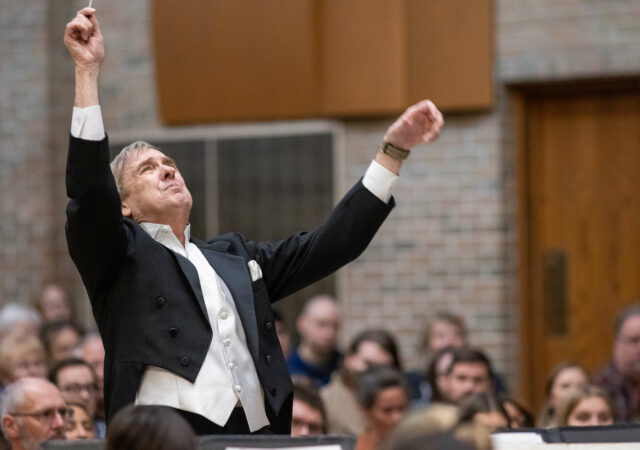By Roland Lovstad
Better health practices, engaging retired clergy, and student recruitment are among efforts that seek to deal with a projected shortage of pastors during the coming decade.
The projections show the Synod will need 300 to 350 new full-time pastors annually just to replace the men who retire or leave active parish ministry. In comparison, approximately 250 seminarians were placed this year. (About 180 seminary graduates were placed in 2006 and 240 pastor-graduates are expected in 2008.)
The projections were provided to Concordia Plan Services by Towers Perrin, a human resource consulting firm. The numbers are based on actual experience with ordained ministers enrolled in the Concordia Retirement Plan (CRP) from 2002 to 2005 and on the demographic profiles of men who are enrolling in the retirement plan as they begin pastoral ministry.
“I know there’s a lot of debate about whether there is a clergy shortage today,” said James Sanft, executive vice president and chief operating officer for Concordia Plan Services, which administers health, disability, and retirement plans for the Synod. “I think the debate is academic. There is clergy shortage looming. We will have one.”
The Synod will experience the effects of the “Baby Boom” generation reaching retirement age, Sanft said.
Between 2006 and 2016, the Towers Perrin report predicts, about 200 pastors will retire annually and another 100 will leave the ministry for other reasons. The company also projects that approximately 25 active parish pastors will die or become disabled annually.
The projections assumed a “no growth” condition in the Synod. The firm did not attempt to project the need for pastors to serve new congregations or missions that might be started through the Ablaze! initiative.
Dr. L. Dean Hempelmann, recently retired after eight years with the Synod’s Boards for Pastoral Education and Higher Education, commented that the average length of service for new pastor candidates will decline by about five years between 2006 and 2016 as more “second-career” pastors replace “full-career” pastors. Today, the average age of a seminary graduate is 41, according to Hempelmann.
Less is known about the 100 pastors who leave the ministry for reasons other than retirement, but Hempelmann said few leave for legal, ethical, or theological reasons. Studies show about one-third leave for other ministry opportunities and one-third leave because of conflict and stress in their ministry situations.
Rev. Glen Thomas, now executive director of the Board for Pastoral Education and formerly on the staff at Concordia Seminary, St. Louis, observed that the full impact is yet to come. He said the number of “non-calling vacancies” is on the increase — comprising more than half of the current pastoral vacancies in the Synod. Those non-calling situations have maintained Word and Sacrament ministries with assistance from retired pastors or neighboring congregations.
“Men are retiring later and not taking early retirement,” said Dr. Carl Fickenscher, dean of pastoral education and placement at Concordia Theological Seminary in Fort Wayne. This may have implied that there is no shortage, he said, adding, “That’s far from the truth, not only because we can use more men to preach the Gospel, but there are opportunities for missions and new congregations.”
The larger task is to build awareness that the shortage is coming, Fickenscher added.
Even though the seminaries placed the largest number of candidates in nearly two decades, Fickenscher observes, “We’re not making our way to 300. This year was a high water mark that shows how high the water needs to rise.”
The looming shortage has caused synodical leaders to look at a number of ways to address the situation. One way is to emphasize student recruitment (see related story). Others are to address health and retention issues.
“Healthy ministers will be able to serve better,” Sanft commented. CPS is working with the Commission on Ministerial Growth and Support to approach issues of health, wellness, and economic vitality. “We want to make sure we are not losing pastors out the back door because of things we can control, like financial management or health issues,” Sanft said.
LCMS workers have higher incidences of diabetes, asthma, and claims related to weight complications than among the wider corporate population, Sanft said. More than 40 percent of claims paid out of the health plan — exceeding $70 million annually — are attributed to health conditions that are preventable, modifiable, or controllable.
Healthier relationships also help to keep pastors in active ministry, according to Rev. David Muench, executive director of the LCMS Commission on Ministerial Growth and Support. One commission project is identifying factors that encourage healthy relationships between pastors and members and between members. The theory is that healthy relationships positively affect the congregation’s mission and ministry.
Another commission project seeks to equip congregations that receive first-call pastors, Muench said. Existing programs help new pastors and their families make a transition from seminary to parish ministry, but this project attempts to help congregations see their role in pastoral formation. Services, study materials, and a networking conference will help lay leaders discuss their expectations and learn communication skills to prepare for their first-call pastors.
A third project, under way in the Indiana District, is connecting interests and skills of retired pastors to ministry needs in congregations. Muench explained that the project matches these abilities with congregations needing additional pastoral assistance, as well as equipping church staffs to work with part-time help.
“By 2010 we hope this will be something that can be applied broadly, including commissioned ministers,” Muench said.
Posted Nov. 20, 2007




